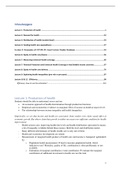College aantekeningen
Summary Lectures Economics of Health and Health Care
- Instelling
- Erasmus Universiteit Rotterdam (EUR)
Lecture notes study book The Economics of Health and Health Care of Sherman Folland, Allen Charles Goodman - ISBN: 9781351595209, Edition: 8, Year of publication: - (-)
[Meer zien]














